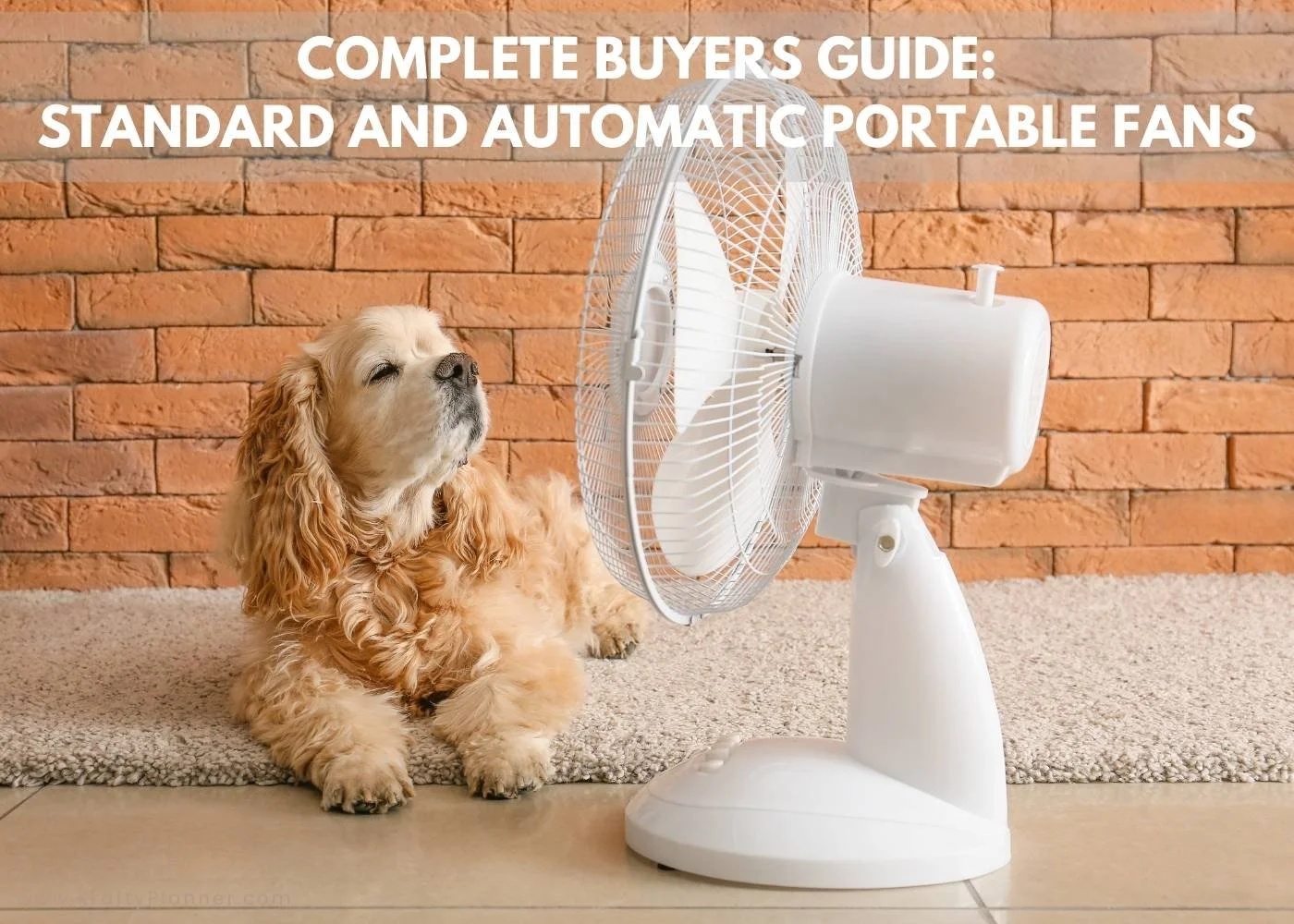Complete Buyers Guide: Standard and Automatic Portable Fans
Portable fans have become essential tools for staying cool, but not all portable fans work the same way. While basic portable fans require manual adjustments for direction and settings, automatic portable fans offer hands-free operation with features like timer controls and automatic swiveling.
The main difference between standard and automatic portable fans lies in their level of user control and convenience features. Standard fans need manual adjustments for speed, direction, and timing. Automatic models include built-in sensors, timers, and motorized swivel functions that adjust airflow without user input.
Modern automatic portable fans like the automatic portable fan from VEVOR or other similar brands combine multiple smart features into one device. These fans can rotate automatically, shut off after set times, and adjust speeds based on conditions. This makes them ideal for camping, offices, and bedrooms where constant manual adjustments would be inconvenient.
Key Takeaways
Standard portable fans require manual control while automatic fans operate independently with smart features
Automatic portable fans offer better convenience through timer functions and automatic swiveling capabilities
Smart features in automatic fans make them more suitable for extended use in various environments
Key Differences Between Standard Portable Fans and Automatic Portable Fans
Standard portable fans require manual control for all functions, while automatic models include sensors and programmable features that adjust operation without user input. The main differences center on control methods, built-in technology, and user convenience features.
Core Functionality Overview
Standard portable fans operate through basic manual controls. Users must physically adjust speed settings, turn the unit on or off, and change direction manually. These fans typically include simple buttons or dials for speed control.
Most standard models offer 3-4 adjustable speed settings. The fan continues running at the selected speed until manually changed or turned off. Direction changes require physical adjustment of the fan head or base.
Automatic portable fans include sensors that detect room conditions. They adjust speed based on temperature, humidity, or motion detection. Many models feature programmable timers and automatic shut-off functions.
These advanced portable fans can switch between different modes automatically. Some detect when someone enters or leaves a room and adjust accordingly.
Manual Versus Automatic Operation
Standard fans require constant user interaction. Every adjustment needs manual input, from speed changes to directional positioning. Users must remember to turn the fan off when leaving a room.
Personal cooling with standard models depends entirely on user preferences. The fan runs at whatever speed was last selected until manually changed.
Automatic models include motion sensors and temperature monitoring. They increase speed when rooms get warmer or when movement is detected. The portable fan reduces speed or turns off when conditions change.
Many automatic units feature learning capabilities. They remember user preferences and adjust operation patterns based on daily routines. This creates more efficient personal cooling without constant manual adjustments.
Battery life improves with automatic models since they reduce power consumption when full cooling isn't needed.
Smart Features and Technology Integration
Standard portable fans typically use basic electrical components. They may include USB-C charging and rechargeable battery systems, but lack advanced electronics. Control remains limited to speed and basic timer functions.
Most standard models feature simple LED indicators showing battery level or current speed setting. The technology focuses on reliable basic operation rather than smart features.
Automatic models integrate advanced sensors and microprocessors. They include temperature sensors, motion detectors, and programmable memory systems. Many feature smartphone app connectivity for remote control.
Smart automatic fans often include multiple charging options including USB-C charging. They may feature longer rechargeable battery life through efficient power management systems.
Some automatic models include air quality sensors that adjust operation based on dust or humidity levels. Others feature sleep modes that gradually reduce speed throughout the night for optimal comfort.
Performance, Usability, and Application Comparison
Standard and automatic portable fans differ significantly in their cooling performance, power management, and user interaction. Automatic models typically provide superior air circulation control and energy efficiency compared to their manual counterparts.
Cooling Efficiency and Air Flow
Standard portable fans operate at fixed speeds that users manually select. This creates consistent air flow but cannot adapt to changing room conditions. The cooling solution remains static throughout operation.
Automatic portable fans use sensors to monitor temperature and humidity levels. They adjust fan speed and direction automatically to maintain optimal air circulation. This responsive approach creates more effective ventilation than standard models.
Air Flow Comparison:
Automatic fans distribute air more evenly across rooms. They can detect hot spots and direct air flow to those areas. Standard fans blow air in one direction without sensing temperature variations.
The automatic adjustment feature helps these fans work better with existing air conditioning systems. They can reduce the workload on central cooling by targeting specific areas that need extra ventilation.
Battery Life and Power Options
Standard portable fans typically run at consistent power levels throughout operation. Battery life depends on the selected speed setting. Higher speeds drain batteries faster than lower settings.
Automatic fans use smart power management to extend battery life. They reduce speed when cooling needs are met and increase power only when necessary. This approach can extend operating time by 20-30% compared to standard models.
Most automatic fans offer multiple power sources including USB charging, wall adapters, and rechargeable batteries. Standard fans usually have fewer power options.
Power Features:
Standard fans: Fixed power consumption, basic charging options
Automatic fans: Variable power use, multiple charging methods, power-saving modes
Battery indicators on automatic models show remaining charge more accurately. They often include low-power alerts and automatic shutdown features to prevent battery damage.
Noise Level and User Experience
Standard portable fans produce consistent noise levels that match their speed settings. Users cannot reduce noise without also reducing air flow effectiveness.
Automatic fans typically run quieter because they operate at lower speeds when full power is not needed. They only increase speed and noise when sensors detect higher temperatures.
The user experience differs significantly between the two types. Standard fans require manual adjustments throughout the day as conditions change. Automatic models work independently once initial settings are configured.
Noise Comparison:
Standard fans: 35-50 decibels at medium speed
Automatic fans: 25-45 decibels with variable operation
Automatic fans often include sleep modes that reduce noise levels during nighttime hours. They can detect reduced activity and adjust operations accordingly. Standard fans maintain the same noise level regardless of time or usage patterns.
Many automatic models include app connectivity and remote controls. Users can adjust settings without physically accessing the fan. Standard fans typically require manual button controls only.
Conclusion
Standard and automatic portable fans serve different purposes for different users. Standard fans offer simple operation and lower costs. Automatic fans provide smart features and better energy savings.
Key factors to consider:
Budget - Standard fans cost less upfront
Convenience - Automatic fans adjust settings on their own
Energy use - Smart features can reduce power consumption
Control needs - Some people prefer manual control over automatic settings
The right choice depends on personal needs and preferences. Users who want basic cooling should consider standard fans. Those who value convenience and smart features will benefit more from automatic models.
Both types of fans can effectively move air and provide cooling. The main difference lies in how much control and automation each person wants in their cooling solution.
BEFORE YOU GO:
Here are a few more posts you might like:
How to Create a Monthly Routine for Cleaning Up Your iPhone Photos
Creating a Peace of Mind Plan: How to Prepare for Unexpected Caregiving Roles
See my Link Party Directory for a current list of blog parties I attend each week.
FOR PERSONAL USE ONLY – Please Read Freebies Terms of Use.
(This post may contain affiliate links. For more information, see my disclosures here.)
~ SHARE THIS POST ~
Did you like this post? Do you know someone else who might enjoy it? Please take a minute to share it on Pinterest, Facebook, or your favorite social media… Thank you!




















